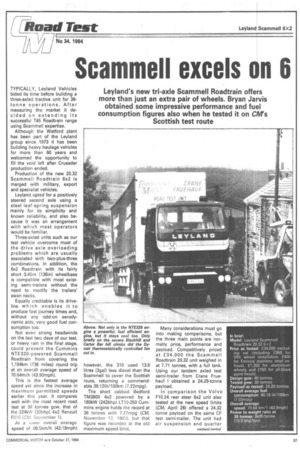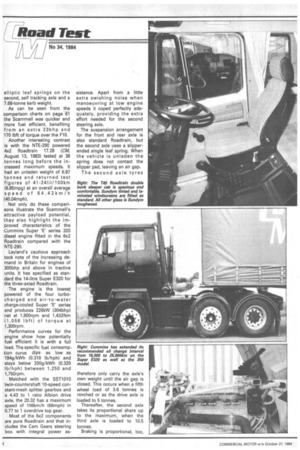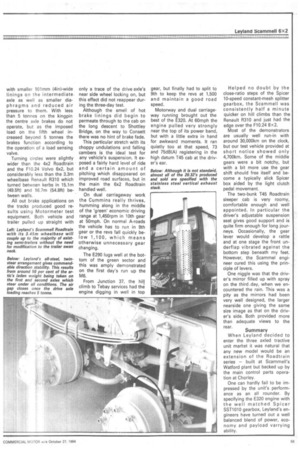Scannell excels on 6
Page 63

Page 64

Page 65

If you've noticed an error in this article please click here to report it so we can fix it.
Leyland's new tri-axle Scammell Roadtrain offers more than just an extra pair of wheels. Bryan Jarvis obtained some impressive performance and fuel consumption figures also when he tested it on CM's Scottish test route
TYPICALLY, Leyland Vehicles bided its time before building a three-axled tractive unit for 38tonne operations. After measuring the market it decided on extending its successful T45 Roadtrain range using Scammell expertise.
Although the Watford plant has been part of the Leyland group since 1973 it has been building heavy haulage vehicles for more than 60 years and welcomed the opportunity to fill the void left after Crusader production ended.
Production of the new 20.32 Scammell Roadtrain 6x2 is merged with military, export and specialist vehicles.
Leyland opted for a positively steered second axle using a steel leaf-spring suspension mainly for its simplicity and known reliability, and also because it was an arrangement with which most operators would be familiar.
Three-axled units such as our test vehicle overcome most of the drive axle overloading problems which are usually associated with two-plus-three combinations. In addition, the 6x2 Roadtrain with its fairly short 3,45m {136in) wheelbase is compatible with most existing semi-trailers without the need to modify the trailers' swan necks.
Equally creditable is its driveline which enables it to produce fast journey times and, without any odd-on aerodynamic aids, very good fuel con surnption too, Not even strong headwinds on the last two days of our test, or heavy rain in the final stage, could prevent the Cummins NTE320-powered Scammell Roadtrain from covering the 1,184km 1736 miles) round trip at an overall average speed of 70,64m/h (43.90mph).
This is the fastest average speed yet since the increase in maximum permitted speeds earlier this year. It compares well with the most recent road test at 38 tonnes gcw, that of the 224kW (3013hp) 4x2 Renault R310 (CM, September 1).
At a iciwer overall average speed of 69.5km/h (43.19mph)
Above: Not only is the NTE320 engine a powerful, fuel efficient engine, but it stays cool too. Only briefly on the severe Rlackhill and Carter Bar hill climbs did the Dynair thermostatically controlled fan cut in.
however, the 310 used 13.6 litres (3gal) less diesel than the Scammell to cover the Scottish route, returning a commendable 39.121it/100km (7.22mpg), The short cabbed Bedford TM3800 4x2 powered by a 180kW (242bhp) LT10-250 Cummins engine holds the record at 38 tonnes with 7.27mpg (CM, November 12, 1923), but that figure was recorded at the old maximum speed limit. Many considerations must go into making comparisons, but the three main points are normally price, performance and payload. Competitively priced at £3 4,00 0 the Scammell Roadtrain 20.32 unit weighed in at 7,71 tonnes, with a full tank. Using our tandem axled test semi-trailer from Crane Fruehauf I obtained a 24.29-tonne payload.
In comparison the Volvo F10.24 rear steer 6x2 unit also tested at the new speed limits (CM, April 28) offered a 24.32 tonne payload on the same CF test semi-trailer. The unit had air suspension and quarter
elliptic leaf springs on the second, self tracking axle and a 7.68-tonne kerb weight.
As can be seen from the comparison charts on page 6i the Scamrnell was quicker and more fuel efficient, benefiting from an extra 23bhp and 170 lbft of torque over the F10.
Another interesting contrast is with the NTE-290 powered 4x2 Roadtrain 17.28 (CM, August 13, 1983) tested at 38 tonnes long before the in creased maximum speeds. It had an unladen weight of 6.97 tonnes and returned test figures of 41-241it/100km (6.85mpg) at an overall average speed of 64.42 km/h (40.04mph).
Not only do these comparisons illustrate the Scammell's attractive payload potential, they also highlight the improved characteristics of the Cummins Super 'E' series 320 diesel engine fitted in the 6x2 Roadtrain compared with the NTE-290.
Leyland's cautious approach took note of the increasing de mand in Britain for engines of 300bhp and above in tractive units. It has specified as standard the 14-litre Super E320 for the three-axled Roadtrain.
The engine is the lowest powered of the four turbo charged and air-to-water charge-cooled Super `E' series and produces 226kW (304bhp) net at 1,900rpm and 1,432Nm (1,056 113ft) of torque at 1,30Orpm.
Performance curves for the engine show how potentially fuel efficient it is with a full load. The-specific fuel consumption curve dips as low as 194g/kWh (0,319 lb/hph) and stays below 200g/kWh (0.320 lb/hph) between 1,250 and 1,75Orpm.
Matched with the SST1010 twin-countershaft 10-speed con
stant-mesh splitter gearbox and a 4.43 to 1 ratio Albion drive axle, the 20.32 has a maximum speed of 1136kr-n/h (66r-nph) in 0.77 to 1 overdrive top gear.
Most of the 6x2 components are pure Roadtrain and that in cludes the Cam Gears steering box with integral power as sistance. Apart from a little extra swishing noise when manoeuvring at low engine speeds it coped perfectly adequately, providing the extra effort needed for the second steering axle.
The suspension arrangement for the front and rear axle is also standard Roadtrain, but the second axle uses a slipperended single leaf spring. When the vehicle is unladen the spring does not contact the slipper pad, leaving an air gap.
The second axle tyres therefore only carry the axle's own weight until the air gap is closed. This occurs when a fifth wheel load of 3.6 tonnes is reached or as the drive axle is loaded to 5 tonnes.
Thereafter, the second axle takes its proportional share up to the maximum, when the third axle is loaded to 10.5 tonnes.
Braking is proportional, too, with smaller 101mm (4in)-wide linings on the intermediate axle as well as smaller diaph ra gm s and reduced air pressure to them. With less than 5 tonnes on the kingpin the centre axle brakes do not operate, but as the imposed load on the fifth wheel increased beyond 5 tonnes the brakes function according to the operation of a load sensing valve.
Turning circles were slightly wider than the 4x2 Roadtrain and the F10.24 Volvo 6x2, but considerably less than the 3.3m wheelbase Renault R310 which turned between kerbs in 15.1m (49.5ft) and 16.7m (54.8ft) between walls.
All out brake applications on the tracks produced good results using Motormeter test equipment. Both vehicle and trailer pulled up straight with Lett: Leyland's Scammell Roadtrain with its 3.45m wheelbase will couple up to the majority of existing semi-trailers without the need for modification to the trailer swan neck.
Below: Leyland's all-steel, twinsteer arrangement gives commendable direction stability. This results from around 50 per cent of the attic's laden weight being taken on the first and second axles which steer under all conditions. The air gap closes once the drive axle loading reaches 5 tonne, only a trace of the drive axle's near side wheel locking on, but this effect did not reappear during the three-day test.
Although the smell of hot brake linings did begin to permeate through to the cab on the long descent to Shottley Bridge, on the way to Consett there was no hint of brake fade.
This particular stretch with its choppy undulations and falling cambers is the ideal test for any vehicle's suspension, It exposed a fairly hard level of ride and a certain amount of pitching which disappeared on improved road surfaces, but in the main the 6x2 Roadtrain handled well.
On dual carriageway work the Cummins really thrives, humming along in the middle of the 'green' economic driving range at 1,450rpm in 10th gear at 50mph. On normal A-roads the vehicle has to run in 9th gear or the revs fall quickly below 1,100, which means otherwise unnecessary gear changing.
The E290 lugs well at the bottom of the green sector and this was amply demonstrated on the first day's run up the M6.
From Junction 37, the hill climb to Tebay services had the engine digging in well in top gear, but finally had to split to 9th to keep the revs at 1,500 and maintain a good road speed.
Motorway and dual carriage way running brought out the best of the E320. At 60mph the engine pulled very strongly near the top of its power band, but with a little extra in hand for awkward moments. It ran quietly too at that speed, 73 and 75dB(A) registering in the high datum T45 cab at the driver's ear. Helped no doubt by the close-ratio steps of the Spicer 10-speed constant-mesh splitter gearbox, the Scammell was consistently half a minute quicker on hill climbs than the Renault R310 and just had the edge over the F10.24 Bx 2.
Most of the demonstrators are usually well run-in with around 30,000km on the clock, but our test vehicle provided at short notice showed only 4,700km. Some of the middle gears were a bit notchy, but with a bit more use the gear shift should free itself and become a typically slick Spicer box aided by the light clutch pedal movement.
The two-bunk T45 Roadtrain sleeper cab is very roomy, comfortable enough and well appointed. In particular the driver's adjustable suspension seat gives good support and is quite firm enough for long journeys. Occasionally, the gear lever would develop a rattle and at one stage the front underflap vibrated against the bottom step beneath my feet. However, the Scammel engineer cured this using the principle of levers.
One niggle was that the driver's mirror filled up with spray on the third day, when we encountered the rain. This was a pity as the mirrors had been very well designed, the larger nearside one giving the same size image as that on the driver's side. Both provided more than adequate views to the rear. Summary When Leyland decided to enter the three axled tractive unit market it was natural that any new model would be an extension of the Roadtrain series — built at Scammell's Watford plant but backed up by the main control parts operation at Chorley.
One can hardly fail to be impressed by the unit's performance as an all rounder. By specifying the E320 engine with the well matched Spicer SST1010 gearbox, Leyland's engineers have turned out a well balanced blend of power, economy and payload varrying ability.


















































































































